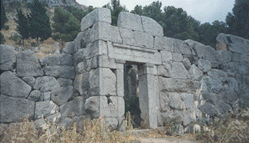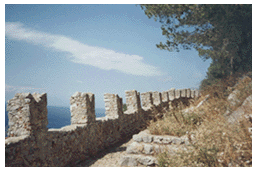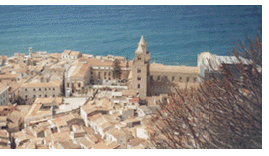Temple of Diana - Best of Sicily Magazine (original) (raw)

 The scenic coastal town is famous for its Norman cathedral and the ruins of a hilltop fortress, but Cefalù boasts a special patrimony that is far more ancient. So far as we know, the town itself was founded by Carthaginians but soon colonised by Greeks. The former had succeeded the Sicans, one of the native peoples of Sicily, whose legacy is best expressed in the megalithic Temple of Diana. This is, of course, simply a Latin name for the Greek goddess Artemis, perhaps identified with the Sicanian deity of the hunt. We know very little about the Sikanians' neolithic religion.
The scenic coastal town is famous for its Norman cathedral and the ruins of a hilltop fortress, but Cefalù boasts a special patrimony that is far more ancient. So far as we know, the town itself was founded by Carthaginians but soon colonised by Greeks. The former had succeeded the Sicans, one of the native peoples of Sicily, whose legacy is best expressed in the megalithic Temple of Diana. This is, of course, simply a Latin name for the Greek goddess Artemis, perhaps identified with the Sicanian deity of the hunt. We know very little about the Sikanians' neolithic religion.
Artemis (or Cynthia for Cynthos, her birthplace), goddess of the woods and hunters, protectress of youth, was widely venerated at Syracuse, which colonised this area. In myth, it was Artemis who changed the Greek maiden Arethusa into the spring which emerges in Syracuse on the island of Ortygia. Artemis was daughter of Zeus and Leto, and the twin sister of Apollo.
The temple's foundation is not unlike that present at Pantalica, featuring large interlocking stones. The upper "classical" sections were added in Greek times. Little else is known of the temple or the people who built it, but to see it you'll have to climb Cefalu's fortified mountain. Steps  and footpaths lead the way.
and footpaths lead the way.
Besides the small temple, the climb is worth the effort for its stupendous views of the cathedral, town and coast. Gradually left to decay over time, the fortress survives in pieces, such as the outer wall encircling the mountain. It was here that Charles the Lame, son and heir of Charles I Anjou, King of Naples, was imprisoned as the "guest" of King Peter of Aragon in 1284 during the War of the Vespers. He was eventually released to be crowned as King Charles II of Naples a few years later.
Few Sicanian structures still stand; Phoenician, Carthaginian, Greek and Roman architecture is far more evident in Sicily. The Sicans, Sicels and Elami amalgamated with successive cultures to the extent that it is often difficult to identify the traces of these earlier "native" civilisations with much precision beyond the earliest Sicilian history - before circa 800 BC. The Sicanian part of the Temple of Diana dates from this early period, though archaeologists disagree on its precise age. It is, however, a witness to time.
This is the earliest-known Sicanian temple in Sicily, but their predecessors the Proto-Sicanians built the temples on Malta - the oldest-known places of worship in Europe.
The twelfth century saw the unique structure used as a chapel. The remains of an apse and arched windows are visible in the rear and interior of the temple. It seems improbable that the Temple of Diana is the oldest existing structure in Sicily, as some have claimed. Future excavations may reveal something more ancient somewhere on this island.
saw the unique structure used as a chapel. The remains of an apse and arched windows are visible in the rear and interior of the temple. It seems improbable that the Temple of Diana is the oldest existing structure in Sicily, as some have claimed. Future excavations may reveal something more ancient somewhere on this island.
Fragments of several small castles are present within the vast medieval wall encircling the plateau. The battlements (crenels) of the highest "castle," at the summit, are a recent - but faithful - reconstruction. Beyond the temple, much of the mountain is wooded with stone pines and other trees. A place worthy of a goddess.
About the Author: Professor Ignazio Lo Verde lectures on classics and architecture.